the place where Paleontology and Paleoanthropology meets Philately
Austria
Dinosaurs and other prehistoric animals, fossils, fossil found places, Charles Darwin on stamps and postmarks of Austria
| << previous country | back to index | next country >> |
Contents:
- Country overview
- Philately of Austria
- Official stamps of Austria related to Paleontology
- Other stamps of Austria to consider
- Personalized stamps of Austria related to Paleontology
- Personalized stamps of Austria to consider: HMS Beagle
- Postmarks and meter franking of Austria related to Paleontology
- Other Postmarks and meter franking of Austria to consider
- References
- Acknowledgements
Austria officially the Republic of Austria (German: Republik Österreich), is a federal republic and a landlocked country of over 8.5 million people in Central Europe. It is bordered by the Czech Republic and Germany to the north, Hungary and Slovakia to the east, Slovenia and Italy to the south, and Switzerland and Liechtenstein to the west. The territory of Austria covers 83,879 square kilometres . Austria's terrain is highly mountainous, lying within the Alps. The majority of the population speak local Bavarian dialects of German as their native language, and Austrian German in its standard form is the country's official language. Other local official languages are Hungarian, Burgenland Croatian, and Slovene. Austria, with its well-developed market economy, skilled labor force, and high standard of living, is closely tied to other EU economies, especially Germany's. [R1]
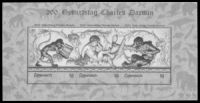
 Since 1946, the standard set of stamp-related philatelic products issued by the Austrian Post include stamps,
an information page or brochure, FDC, but also a Black Print.
The information page or brochure includes a brief description of the issue and some technical details.
The Black Print is an ungummed, imperforate proof printed in black from the original printing plates.
Black prints are distributed by the Austrian Post, but are not valid postage.
Limited numbers (about 500) of these philatelic souvenirs are printed.
Since 1946, the standard set of stamp-related philatelic products issued by the Austrian Post include stamps,
an information page or brochure, FDC, but also a Black Print.
The information page or brochure includes a brief description of the issue and some technical details.
The Black Print is an ungummed, imperforate proof printed in black from the original printing plates.
Black prints are distributed by the Austrian Post, but are not valid postage.
Limited numbers (about 500) of these philatelic souvenirs are printed.Another unusual feature of Austrian Post is production and distribution at official Philatelic Bureau of kind of "official personalized" stamps. Distinguished from regular personalized stamps, produced for private persons or companies the "official personalized" stamps produced in big topical sets and offered at face value price. [R2]
Official stamps of Austria related to Paleontology: fossils, Charles Darwin
| 30.04.1976 "Vienna Natural History Museum Centennial" | 12.01.1999 "150th anniversary of the Austrian Geological Survey" | 24.11.2009 "200th anniversary Charles Darwin" |
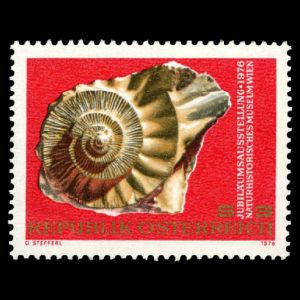 |
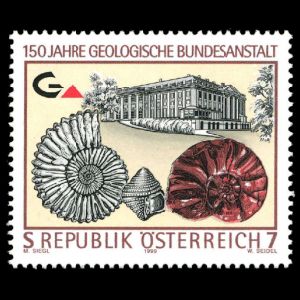 |
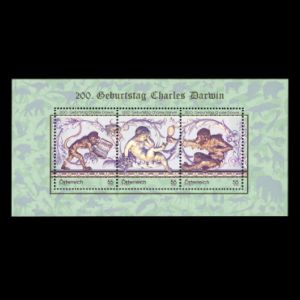 |
Other stamps of Austria to consider: contributors to Paleontology, prehistoric animals as art objects, Natural History Museum
| 31.10.1980 "100th anniversary of Alfred Wegener" [A1] | 20.07.1983 "150th anniversary of Carl Freiherr von Hasenaer" [A2] | 26.04.1989 "Eduard Suess (1831-1914)" [A5] | |
 |
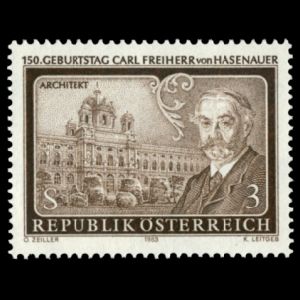 |
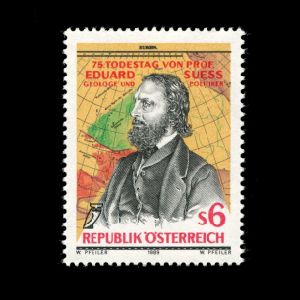 |
|
| 06.04.2013 "Postojna Cave" [A4] | |||
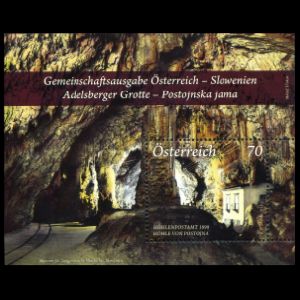 |
|
||
| "Lindwurmbrunnen von Klagenfurt" [A3] | |||
| 22.01.1968 "Lindwurmbrunnen von Klagenfurt" | 12.09.2013 "Architecture" | 01.03.2015 "Lindwurm von Klagenfurt" | |
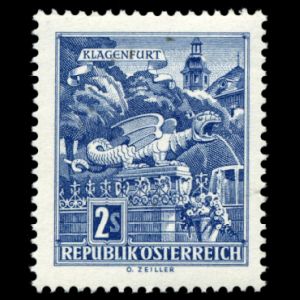 |
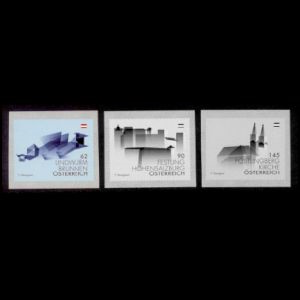 |
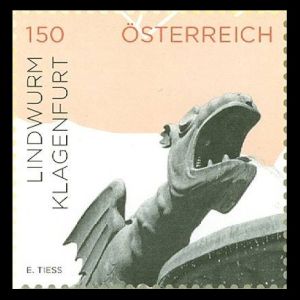 |
|
Notes:
[A1] Alfred Wegener - German polar researcher, geophysicist, meteorologist and the originator of the theory of continental drift. [R8]
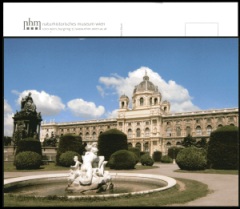 [A2] Baron Karl von Hasenauer (Carl Freiherr von Hasenauer), was an important Austrian architect
who designed the building of the Museum of Natural History in Vienna, that shown on the background of the stamp.
[A2] Baron Karl von Hasenauer (Carl Freiherr von Hasenauer), was an important Austrian architect
who designed the building of the Museum of Natural History in Vienna, that shown on the background of the stamp. The Museum of Natural History in Vienna (German: Naturhistorisches Museum Wien) is a large natural history museum located in Vienna, Austria and it is one of the most important natural history museums worldwide.
The museum's 39 exhibition rooms cover 8,460 square meters and present more than 100,000 objects, includes very extensive exhibition of fossils and replication of prehistoric animals. [R9]
So far there are any stamp dedicated to the Museum of Natural History in Vienna, but the museum uses a meter franking with its building and also produced some special commemorative postmarks and meter franking to attract potential visitors to show its special exhibitions.
Some dinosaurs from collection of the Museum of Natural History in Vienna on its postcards:

[A3] Legend has it that Klagenfurt was founded after a couple of brave men had slain the abominable "Lindwurm", a winged dragon in the moors adjoining the lake, the staple diet of which is said to have been virgins, but which did not spurn the fat bull on a chain that the men had mounted on a strong tower.
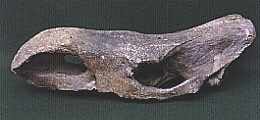
|
| The skull of Woolly Rhinoceros. Image credit: Wikipedia |
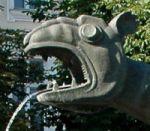
|
| The head of Klagenfurt Lindwurm fountain. Image credit: Wikipedia |
[A4] Joint issue with Sloevenia.
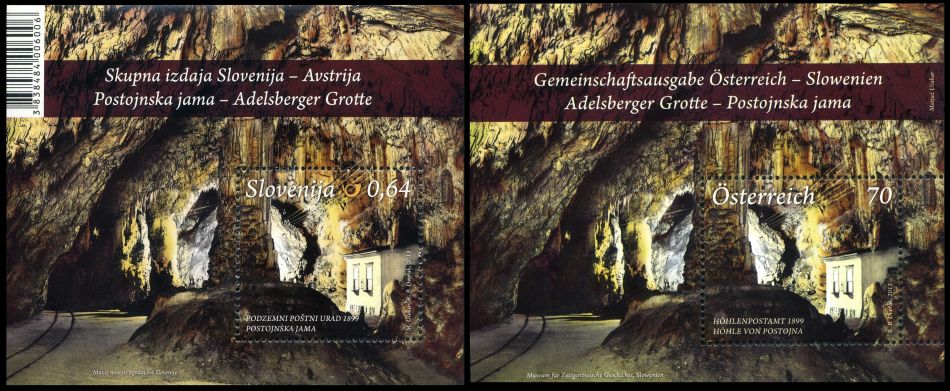
Postojna Cave is a 24,340 m long karst cave system near Postojna, southwestern Slovenia. It is the second-longest cave system in the country (following the Migovec System) as well as one of its top tourism sites. Postojna Cave was carved by the Pivka River over millions of years.
Some fossils of Cave Lion depicted on Slovenian stamps in 2017 are found in the cave.
The cave was first described in the 17th century when Slovenia was part of Austro-Hungarian Empire.
In 1899 August 15th, Austria opened the first underground cave post office in the world, near Kongresna Dvorana 500m inside the cave from the entrance.
In 1927, another cave post office was opened – in the Concert Hall. This post office is in operation till today and is world’s only underground post office. [R16]
[A5] Eduard Suess (1831-1914) - geologist who "discovered" prehistoric Gondwana continent. He proposed the land bridge model for the distribution of fossil organisms.
He suggested that Gondwana was a supercontinent where land bridges had risen up out of the oceans to connect the modern continents together – so the animals could just walk across the bridge.
(He was influenced by the Bering Sea Land bridge between Eurasia and North America that had been described by that point).
He thought the continents were fixed in place – so the bridges had to pop up and then sink back down later on – but had no mechanism to explain how it worked nor had any idea what oceanic crust was made of. [R10]
It is less known, Eduard Suess discovered some dinosaur bones and some dinosaur species named after him - Iguanodon suessii, later on it was reassigned to a new genus Mochlodon and the species renamed to Mochlodon suessii.
For more details, please, click here.
Personalized stamps of Austria related to Paleontology: dinosaurs and other prehistoric animals
| ??.??.2011 "Prehistoric animals" | ||
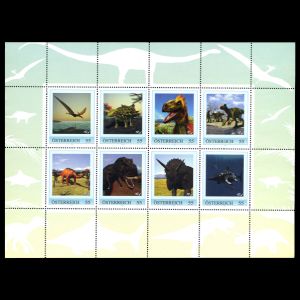 |
|
|
Personalized stamps of Austria to consider: HMS Beagle, prehistoric animals as art objects
| ??.??.2018 "200th anniversary of Charles Darwin" | 02.05.2018 "Sightseeing of Austria" [A4] | |
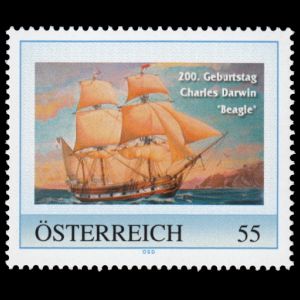 |
 |
|
Notes:
[P1] HMS Beagle was a Cherokee-class 10-gun brig-sloop of the Royal Navy, one of more than 100 ships of this class. On the second voyage a young naturalist named Charles Darwin was on board; the pivotal role this round the world voyage played in forming his scientific theories made the HMS Beagle one of the most famous ships in history. Darwin had kept a diary of his experiences, and rewrote this as the book titled Journal and Remarks, published in 1839 as the third volume of the official account of the expedition. This travelogue and scientific journal was widely popular, and was reprinted many times with various titles, becoming known as The Voyage of the Beagle. This diary is where Darwin drew most of the ideas for his publications. Darwin attributes his first real training in natural history to his voyage on the Beagle. [R12]
Commemorative postmarks and meter franking of Austria related to Paleontology: fossils, prehistoric animals, dinosaurs, Charles Darwin, Natural History Museum
Legend is here| 15.08.1960 "Natural history on stamps" [Sp] | 26.9.1969 "Meeting Geology and Philately in Linz" [Sp] | 1974 "100 years since discovery in Stillfried" [Sp] [C1] |
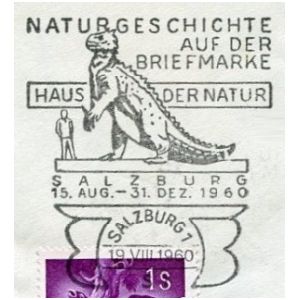 |
 |
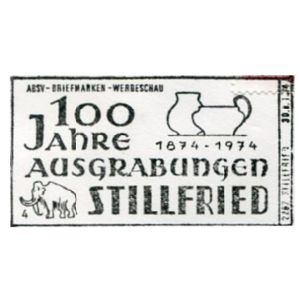 |
| 30.04.1976 "Vienna Natural History Museum Centennial" [FDC] | 1980 "Natural history museum" [PM] | 22.11.1983 "Natural history museum" |
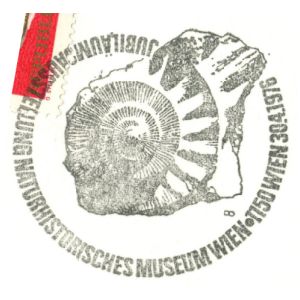 |
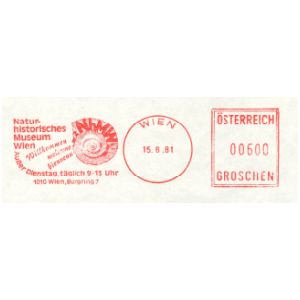 |
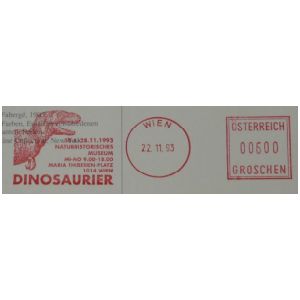 |
| 21.08.1983 "3rd philateliec hiking and advertising show in Gosau" [Sp] | 25.09.1983 "IBSV Stamps Show in Mettmach" [Sp] [C6] | 1985-1993 "Visit Horm and its Museums" [PM] [C2] |
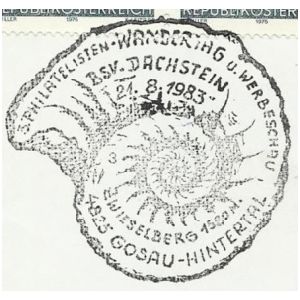 |
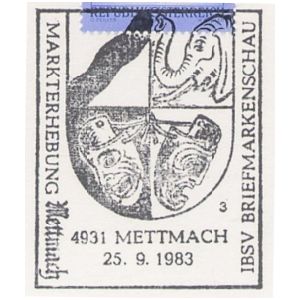 |
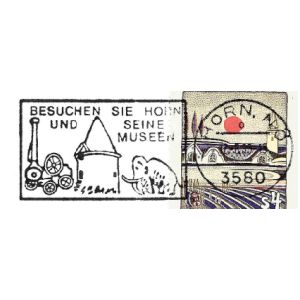 |
| 1989 "Mettmach your vacation target" [PM] [C6] | 1989 "Natural History Museum of Vienna" [PM] | 27.2.1991 "90 years of Krahuletsmuseum in Eggenburg. Meeting of Palaontological society" [Sp] [C3] |
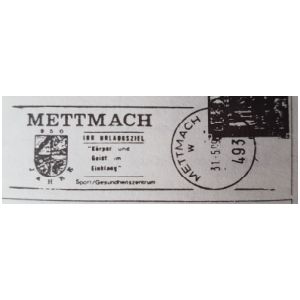 |
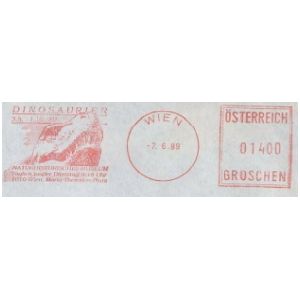 |
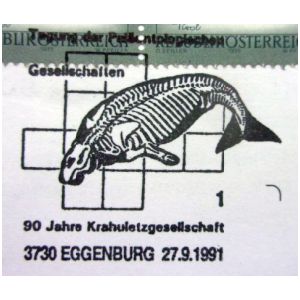 |
| 03.01.1991 "Stamps exhibition of Youth group JUPHILA" | 01.05.1993 "Giants of prehistoric times" [Sp] | 13.03.1994 "20 years of mineral show VOOM in St. Polten" [Sp] |
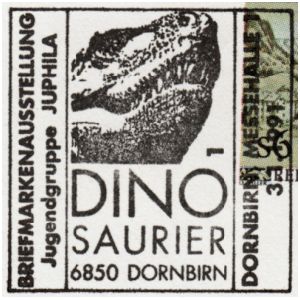 |
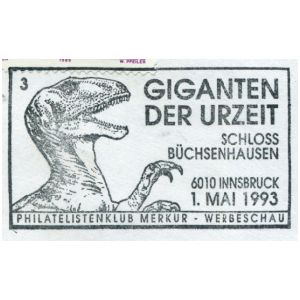 |
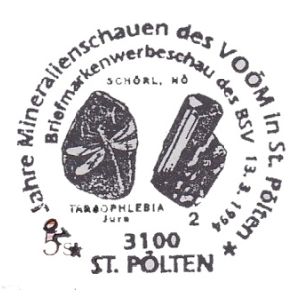 |
| 12.03.1995 "Fossils and Minerals trade show in Voom" [Sp] | 01.07.1995 "950 years of Stillfried-Grub. Open prehistoric museum" [Sp] [C1] | 1991- 1998 "Ernstbrunn natural park" [PM] |
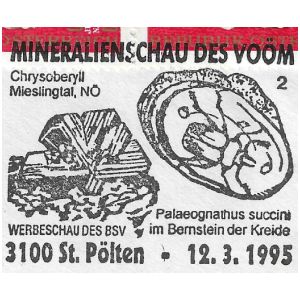 |
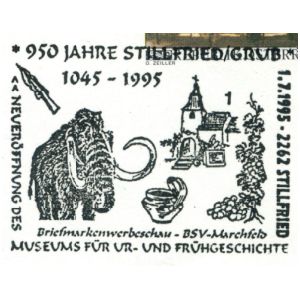 |
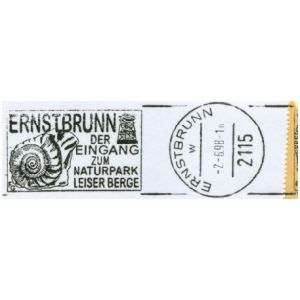 |
| 20.03.1999 "100 year anniversary of the death of Franz V. Hauers, Found of the Paleontology School in Vienna." [Sp] [C4] | 24.11.2009 "200 anniversary Charles Darwin" [FDC] | 21.06.2013 "World heritage Dolomiten, exhibition in Eppan 2013" [Sp] [C5] |
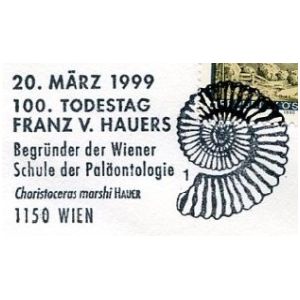 |
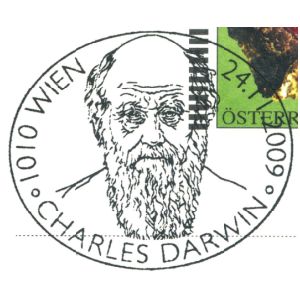 |
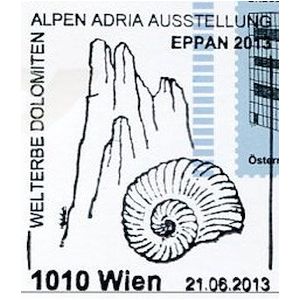 |
Notes:
[C1] Paleolithic hunters lived in the Stillfried area about 25,000 years ago. In a grassy landscape with few bushes and trees they hunted mammoth, rhinoceros, wild horse, reindeer, ice fox and mountain hare. Many remains of prehistoric animals and stone edge tools found in Stillfried can be seen in the local museum. [R3]
[C2]
[C3] The oldest fossil in the Krahuletz Museum date back to the Permian age, 300 million years ago, and were found in Kamptal.
Fossil animals such as the Eggenburg crocodile or the sea cow Metaxytherium krahuletzi (depicting on the postmark) are among the highlights of their collection and established their worldwide fame.
The scientific name of our manatees is "Metaxytherium krahuletzi", they were named after Johann Krahuletz, who had found the first bones. They lived about 20 million years ago on the coast of the tropical Eggenburg Sea.
In the community sand pit of Kuehnring seven almost complete skeletons of manatees were discovered, which had probably died together during a storm surge and debris avalanche. [R4]
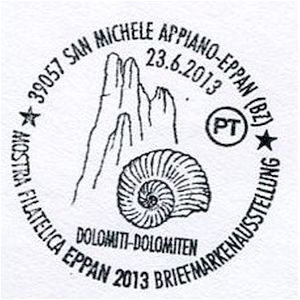
[C4] Franz Ritter von Hauer, or Franz von Hauer (1822-1899), was an Austrian geologist and paleontologist. Among his special geological works are those on the Cephalopoda of the Triassic and Jurassic formations of Alpine regions (1855-1856). He recognized and discovered 89 species and established the Middle and Late Triassic stratigraphical units of deep shelf environments. [R5]
[C5] Italy issued a very similar postmark
[C6] In the 1960 a tusk of a Gomphotherium angustidens was found in a pit near the town of Mettmach in Austria. They put this prehistoric elephant on their coat of arms. [R6]
[C7]
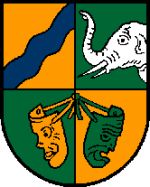
|
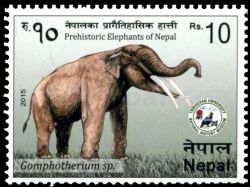
|
| Gomphotherium angustidens on coat of arms of Meemach town in Austria" |
Gomphotherium on post stamp of Nepal 2015. MiNr.: 1183 Scott: 983 |
It had four tusks, two on the upper jaw and two on the elongated lower jaw. The lower tusks are parallel and shaped like a shovel and were probably used for digging up food from mud. Unlike modern elephants, the upper tusks were covered by a layer of enamel. Compared to elephants, the skull was more elongated and low, indicating that the animal had a short trunk. These animals probably lived in swamps or near lakes, using their tusks to dig or scrape up aquatic vegetation. [R7]
Other Commemorative postmarks and meter franking of Austria to consider
Legend is here| 22.01.1968 "Lindwurmbrunnen von Klagenfurt" [FDC] [A3] | 03-04.07.1971 "Christian Leopold von Buch" [Sp] | .1982 "Geology in service of Austria - Vienna Federal Geological Institute" [Pm] |
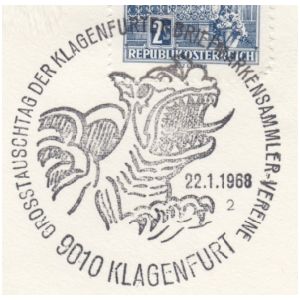 |
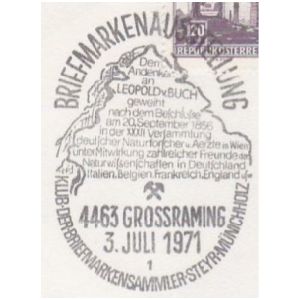 |
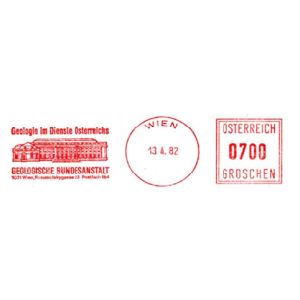 |
| 22.08.1982 "2nd philatelic hiking day of Stamp Collectors Club of Dachstein" [Sp] [CA1] | 17.06.1988 "Stamps show of Youth philatelic club JUPHILA" [CA1] | 25.01.1989 "38th International ski customs championships" [Sp] [CA1] |
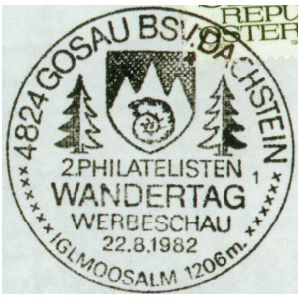 |
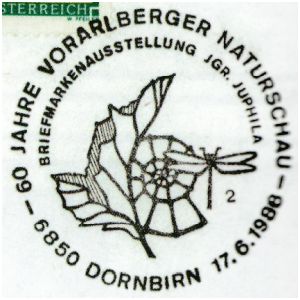 |
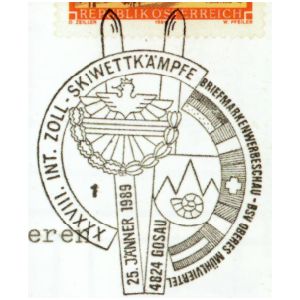 |
| 29.02.1992 "17th International Mineral show" [Sp] [CA1] | 04.06.1995 "40th anniversary of Youth philatelic group" [Sp] | 27.?.1995 "Lindwurmbrunnen von Klagenfurt" [A3] [Sp] |
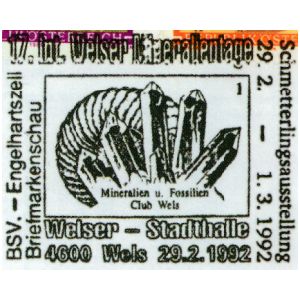 |
 |
 |
| 11.07.1997 "Lindwurmbrunnen von Klagenfurt" [A3] [Sp] | 1998 "Natural History Museum in Vienna" [A2] [PM] | 12.01.1999 "150th Anniversary of the Austrian Geological Survey" [FDC] |
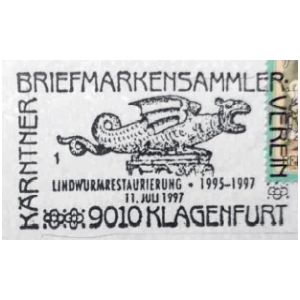 |
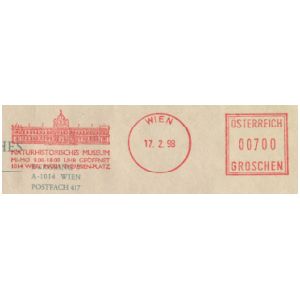 |
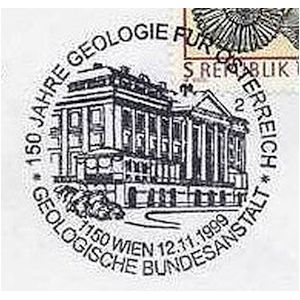 |
| 2002 "Natural History Museum in Vienna" [A2] [PM] [N] | 2003 "Kovac Stahl KG" [CA2] | |
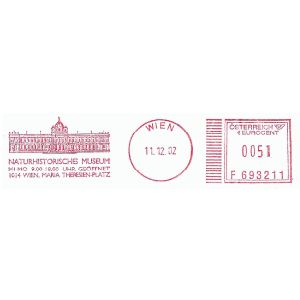 |
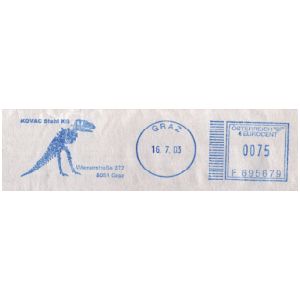 |
Notes:
[CA1] Stylized Ammonite on commemorative postmark of some philatelic clubs.
[CA2] Stylized theropod dinosaur without arms on meter franking of commercial company from Graz.
References:
- [R1] Austria: Wikipedia, WikiTravel, FlagCounter.
- [R2] Postal History and Philately of Austria:
Wikipedia,
Links to official website of the Post Authority, stamp catalog and a list of new stamps of Austria are here. - [R3] Stillfried Museum: official site
- [R4] Krahuletz Museum: official site
- [R5] Franz Ritter von Hauer: Wikipedia
- [R6] Mettmach: Wikipedia
- [R7] Gomphotherium: Wkipedia (on English), Wkipedia (German - more detailed description)
- [R8] Alfred Wegener: Wikipedia, continental drift at Wikipeadia.
- [R9] Museum of Natural History in Vienna:: official site, Wikipedia, Baron Karl von Hasenauer architect of the museum's building.
- [R10] Eduard Sues: Wikipedia, Jewish Virtual Library, Gondwana continent
- [R11] Klagenfurt: Wikipedia, the skull of Woolly Rhinoceros from Klagenfurt.
- [R12] HMS_Beagle: Wikipedia
- [R13] Struthiosaurus: Wikipedia; "Die Reptilfauna der Gosauformation in der Neuen Welt bei Wiener Neustadt", Emanuel Bunzel, Wien, 1871 (in German); website of Winzendorf Muthmannsdorf community (in German);
- [R14] Mochlodon: Wikipedia;
- [R15] Grünbach Formation: Wikipedia;
- [R16] Postojna Cave: Wikipedia, postojnska-jama.eu, philateli.blogspot.
Acknowledgements:
Many thanks to
- Dr. Peter Voice from Department of Geological and Environmental Sciences, Western Michigan University, for the draft page review and his very valuable comments.
- fellow collector Mr. Maxim Romashchenko from Canada, for his help in finding some missing philatelic stuff of Austria.
| << previous country | back to index | next country >> |